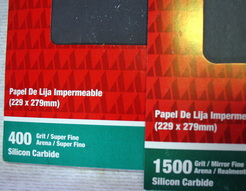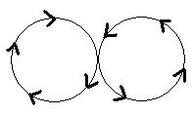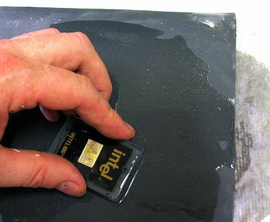Removing Heavy Scratches & Dings
in Lucite & Acrylic Plastics
Wet Sanding & Polishing Lucite

400 & 1500 grit 'wet' sandpaper sheets
Very deep scratches in your Acrylic & Lucite Collectibles may require wet sanding and/or polishing them out with buffing compounds. (A deep scratch is one so deep that it catches your fingernail.)
For very deep scratches wet sanding is required. (Dome Shaped items or any others that have a curve shape will require sanding by hand, DO NOT Sand these curved items on a Flat surface as you will put flat spots in them.

Wet Sand in a Figure-8 Motion
In the case of wet sanding plastic Keychains, the metal ring that attaches the key ring to the Lucite item should first be removed so the item can be placed flat on the sandpaper. Usually a small pair of pliers can be used to expand the keyring just enough to remove it, reinstall the keyring after item has completed it's sanding and polishing.
Next, wet sand the item lightly with a 400-grit "wet " sandpaper, place sandpaper on a very flat surface, move the item to be sanded in a figure-8 motion while using plenty of water and rinsing the sandpaper frequently, stopping often to observe when the deep scratches have been removed, at this point do not worry about fine scratches or hazing.
Next, wet sand the item lightly with a 400-grit "wet " sandpaper, place sandpaper on a very flat surface, move the item to be sanded in a figure-8 motion while using plenty of water and rinsing the sandpaper frequently, stopping often to observe when the deep scratches have been removed, at this point do not worry about fine scratches or hazing.
|
|
 Wet sanding a keychain to remove deep scratches
Rinse it well - it will look hazy but it should look even & without the large scratches now, repeat with 1500 grit "wet" sandpaper using the same procedure to remove the smaller scratches that the 400 grit sandpaper made. A slight rounding over with the wet sandpaper on the edges will take off any sharp edges caused by the flat sanding.
Follow by buffing the item, either by hand with a cloth or with a clean muslin or felt wheel, and a good plastic polishing compound (we prefer to polish our items using Novus #3 then followed up by Novus #2 using a Dremel Tool with a felt wheel on it). This will remove the hazing and the item will now become crystal clear like when it was new. The hazing that was present after sanding is made up of very fine micro-scratches and will polish out easily with buffing now. For best results use only one composition per buff. For the highest gloss, use a clean-up wheel made of soft cotton or flannel sections and on which no compound is used. An electric drill motor or a Dremel tool with a buffing wheel attached works well if a large buffing motor is not available. (for more on the final polishing procedure please refer to our procedure in our Light Scratch Removal section.) |